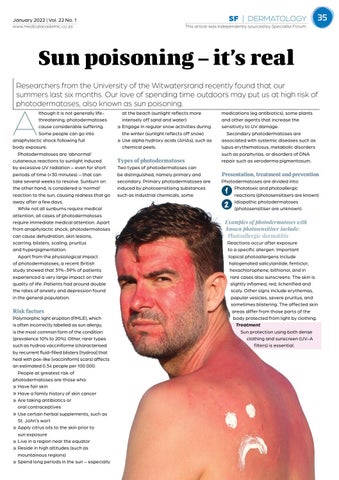SF | DERMATOLOGY
January 2022 | Vol. 22 No. 1
35
This article was independently sourced by Specialist Forum.
www.medicalacademic.co.za
Sun poisoning – it’s real Researchers from the University of the Witwatersrand recently found that our summers last six months. Our love of spending time outdoors may put us at high risk of photodermatoses, also known as sun poisoning.
A
lthough it is not generally lifethreatening, photodermatoses cause considerable suffering. Some people can go into anaphylactic shock following full body exposure. Photodermatoses are ‘abnormal’ cutaneous reactions to sunlight induced by excessive UV radiation – even for short periods of time (<30 minutes) – that can take several weeks to resolve. Sunburn on the other hand, is considered a ‘normal’ reaction to the sun, causing redness that go away after a few days. While not all sunburns require medical attention, all cases of photodermatoses require immediate medical attention. Apart from anaphylactic shock, photodermatoses can cause dehydration, skin lesions, scarring, blisters, scaling, pruritus and hyperpigmentation. Apart from the physiological impact of photodermatoses, a recent British study showed that 31%-39% of patients experienced a very large impact on their quality of life. Patients had around double the rates of anxiety and depression found in the general population.
Risk factors Polymorphic light eruption (PMLE), which is often incorrectly labelled as sun allergy, is the most common form of the condition (prevalence 10% to 20%). Other, rarer types such as hydroa vacciniforme (characterised by recurrent fluid-filled blisters [hydroa] that heal with pox-like [vacciniform] scars) affects an estimated 0.34 people per 100 000. People at greatest risk of photodermatoses are those who: » Have fair skin » Have a family history of skin cancer » Are taking antibiotics or oral contraceptives » Use certain herbal supplements, such as St. John’s wort » Apply citrus oils to the skin prior to sun exposure » Live in a region near the equator » Reside in high altitudes (such as mountainous regions) » Spend long periods in the sun – especially
at the beach (sunlight reflects more intensely off sand and water) » Engage in regular snow activities during the winter (sunlight reflects off snow) » Use alpha hydroxy acids (AHAs), such as chemical peels.
Types of photodermatoses Two types of photodermatoses can be distinguished, namely primary and secondary. Primary photodermatoses are induced by photosensitising substances such as industrial chemicals, some
medications (eg antibiotics), some plants and other agents that increase the sensitivity to UV damage. Secondary photodermatoses are associated with systemic diseases such as lupus erythematosus, metabolic disorders such as porphyrias, or disorders of DNA repair such as xeroderma pigmentosum.
Presentation, treatment and prevention Photodermatoses are divided into: Phototoxic and photoallergic reactions (photosensitisers are known) Idiopathic photodermatoses (photosensitiser are unknown).
1
2
Examples of photodermatoses with known photosensitiser include:
Photoallergic dermatitis Reactions occur after exposure to a specific allergen. Important topical photoallergens include halogenated salicylanilide, fenticlor, hexachlorophene, bithionol, and in rare cases also sunscreens. The skin is slightly inflamed, red, lichenified and scaly. Other signs include erythemas, papular vesicles, severe pruritus, and sometimes blistering. The affected skin areas differ from those parts of the body protected from light by clothing. Treatment Sun protection using both dense clothing and sunscreen (UV-A filters) is essential.













